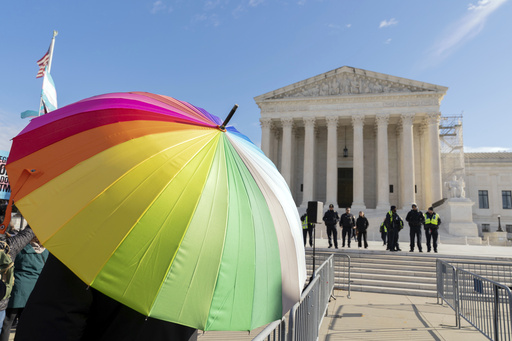One of the key points of discussion during Donald Trump’s presidential campaign was the issue surrounding transgender athletes. Trump frequently brought up this topic at his rallies, emphasizing that one of his objectives during a potential second term would be to “exclude men from women’s sports.” This created a significant debate that drew substantial advertising investments, transforming an issue affecting a small group into a contentious political topic.
According to the AP VoteCast survey, which polled over 120,000 voters nationwide, a majority of voters, particularly Trump supporters, expressed the sentiment that support for transgender rights had gone too far. However, it’s uncertain what specific actions Trump will implement once he assumes office on January 20. His transition team has not provided detailed plans, though he indicated during his campaign that addressing these issues would be relatively straightforward.
Throughout his campaign, Trump seemed to view the conversation surrounding transgender rights, particularly related to sports, as a means to attract a wider audience beyond his typical supporters. He often used language that LGBTQ+ advocates argued was harmful and incorrect. In one notable instance, he incorrectly identified two female Olympic boxers as men and stated their participation in the upcoming Paris Games was “demeaning to women,” despite both athletes being assigned female at birth and identifying as women.
As Election Day approached, Trump’s rhetoric intensified. At a rally in October held at Madison Square Garden, he declared, “We will get… transgender insanity the hell out of our schools, and we will keep men out of women’s sports.”
When considering the powers of the presidency in this matter, Trump has suggested that on his first day in office, he would withdraw federal funding from any educational institution that promotes “critical race theory, transgender insanity, and other inappropriate racial, sexual or political content.” This raises significant questions about how his administration will interpret Title IX, which is essential for ensuring gender equity in athletics and preventing sexual harassment in educational settings.
Every presidential administration has the authority to interpret Title IX differently. The previous two administrations provide insight into this evolving narrative. Under Trump’s first term, then-Education Secretary Betsy DeVos issued a 2020 policy that redefined sexual harassment and limited the obligation of colleges to investigate reported incidents to specific officials. This policy was later rolled back by the Biden administration, which put forth a ruling that protected the rights of LGBTQ+ students and introduced new measures for campus sexual assault victims. While the Biden administration’s policy did not specifically address transgender athletes, several Republican-led states quickly contested it in court.
It is anticipated that Trump will revert the definition of “sex” under Title IX to that of the gender assigned at birth rather than recognizing gender identity. Under the first Trump administration, the government interpreted “sex” strictly as the gender assigned at birth. The Biden administration, in contrast, recognized “sex” as synonymous with gender identity, potentially offering protections for trans athletes in sports that align with their self-identified gender.
The total number of transgender athletes currently active in various sports remains largely uncertain. The NCAA, for example, does not maintain statistics on its more than 544,000 athletes concerning transgender participation. However, NCAA president Charlie Baker acknowledged in Congress that he was aware of fewer than ten active transgender athletes within the organization. A 2019 survey conducted by the Gay, Lesbian and Straight Education Network (GLSEN) highlighted that only 5% of high school respondents competed in sports that matched their gender identity.
A broader analysis suggests that approximately 300,000 high school students aged 13 to 17 identify as transgender, yet it is likely only a small fraction participates in sports. Each instance of a transgender athlete either competing or believed to be competing tends to garner significant media attention, as evidenced by the cases of Lia Thomas from the University of Pennsylvania and the San Jose State volleyball team.
When looking at high school regulations, there is considerable variation across states. Around half have introduced laws effectively banning transgender athletes from competing based on their gender identity. In many situations, these laws were enacted without instances of problematic participation being reported. For instance, in Utah, state legislators overridden a governor’s veto despite only one transgender girl being affected by the ban in K-12 sports.
At the college level, the NCAA set forth a policy in 2010 requiring transgender athletes assigned male at birth to undergo at least one year of testosterone suppression therapy to qualify for participation in women’s teams. Conversely, transgender athletes assigned female at birth transitioning to male are eligible to compete on men’s teams, although they cannot participate in women’s teams if they’ve undergone testosterone treatment. They must also adhere to specific testosterone levels during the season.
In a move toward aligning practices with national sports governing bodies, the NCAA revised its policy in 2022, elevating the standards required for transgender participation to international levels. Some sports have implemented stricter measures; for example, World Aquatics now permits transgender athletes to participate in women’s events only if they can demonstrate that they have not undergone any part of male puberty.
For institutions affiliated with the National Association of Intercollegiate Athletics (NAIA), a unanimous vote earlier this year effectively barred transgender athletes from competing in women’s sports.
At the Olympic level, the International Olympic Committee (IOC) has largely deferred responsibility to international federations for each sport. This situation may evolve following the election of a new IOC president to succeed the retiring Thomas Bach. Among the candidates is former athlete Sebastian Coe, who has been vocal about limiting participation to cisgender women.
Looking ahead, the landscape for transgender athletes is poised for significant shifts, resembling the battlegrounds seen with post-Dobbs abortion access. Democrats appear divided on how to address these issues. There remains a possibility for a Republican-majority Congress to introduce another version of the “Protection of Women and Girls in Sports Act,” originally proposed in 2021 and 2023, which aims to prohibit individuals assigned male at birth from participating in female sports programs. While the 2023 bill passed in the House, it did not reach a Senate vote, despite the prevailing discussion around transgender athletes. With Democrats potentially diversifying representation, including Sarah McBride, the first openly transgender congressional member, the situation holds promise for engaging discourse.




